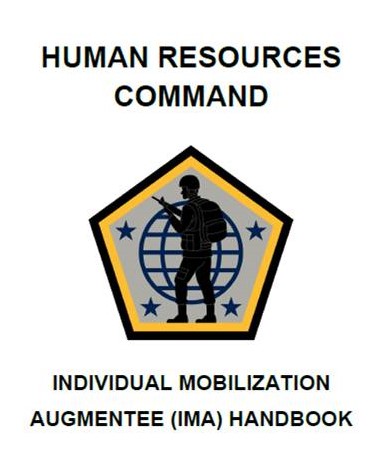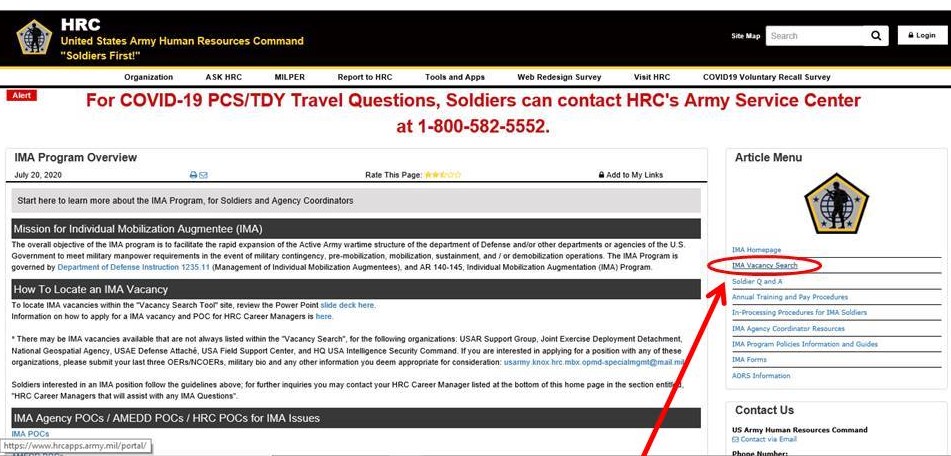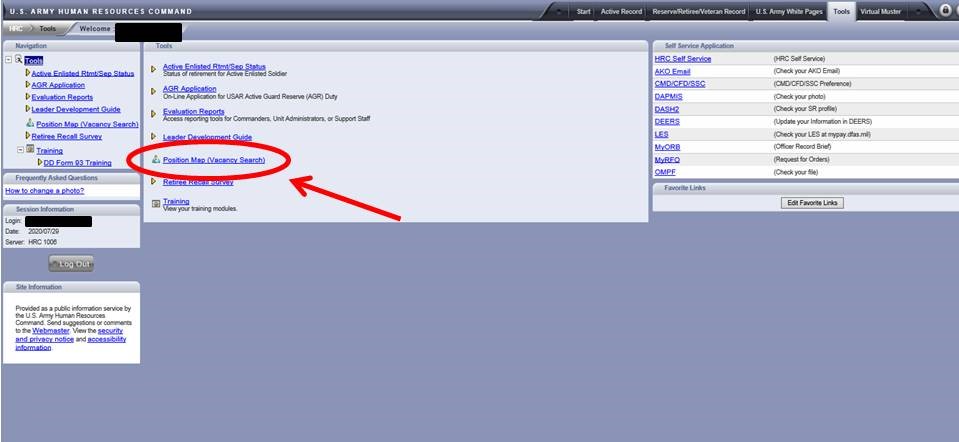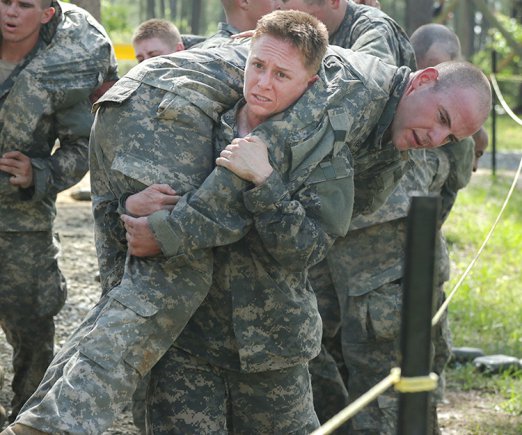THE IMA PROGRAM
August 3, 2020
A DESERT OASIS NOBODY’S TOLD YOU ABOUT
Are you at a point in your Army career where you’re just not sure if it’s worth it anymore? The daily grind of SITREPs, PowerPoint, and FRAGOs has you down? DTMS, GCSS-A, eMILPO, and 350-1 training got you in the dumps? Maybe you’re just not having fun anymore, you’re not serving in the capacity that you think you’re best equipped to contribute, or it’s putting too much strain on your family. I’d venture to say that these sentiments apply to a more significant percentage of our population than we’d like to admit.
Well, there may be a very welcome oasis in a seemingly barren desert if you can just make it through your initial service obligation. I mean, Moses wandered the desert for 40 years…so if he can do it, so can you. The Promised Land is there waiting for you if you’re self-motivated, take extreme initiative, and are willing to navigate some bureaucracy.
What I’m about to share with you is an opportunity that affords you the ability to still serve and contribute, but also provides you with a considerable degree of flexibility, autonomy, and just maybe…some semblance of work/life balance. What a concept! If you are seriously considering leaving the Active Duty Army, this may be of interest to you.
I learned about the Individual Mobilization Augmentee (IMA) Program sometime within the last year through random cold call conversations with Army Reserve soldiers I found through the Microsoft Outlook email global address directory. No one in the active duty world has ever mentioned it to me–which is understandable–considering most people are focused on their active duty positions and retaining people within the active component. There’s no real incentive for people to learn about the IMA Program or share this information, so it kind of just remains unintentionally hidden. With respect to stress, time commitment, and participation–on a scale of IRR to Active Duty–the IMA Program falls somewhere just above IRR and just below TPU (Regular Reserve and National Guard) organizations. Requiring a considerably greater amount of participation than the IRR, but characterized by a much more customizable method of contributing, the IMA Program could be for you.

The Army HRC website published an updated information handbook in March of 2020. The file is available for download at the end of the article. Feel free to check it out so you can read about this program straight from the source!
SO WHAT EXACTLY IS THE IMA PROGRAM?
This is a bit of an oversimplification, but essentially, the IMA Program allows you to serve your “one weekend a month, two weekends in the summer” traditional National Guard/Regular Reserve commitment all at once–or split up into multiple periods–or really whatever you want! IMA soldiers are able to negotiate their service for the fiscal year with their rater/boss based off of the needs of the unit and obviously your own civilian job and family. This is something that may be a bit more appealing to you if the very prescriptive “one weekend a month and two weeks in the summer” itinerary seems to be a bit too rigid. In some cases, this could look like blocking your annual training (“two weeks”) and several drill days around a key event when the unit requires additional assistance. Does this sound too good to be true? I promise, it’s not a trap!!

I swear on my life…and no, the Army Reserve is not paying me to peddle lies.
Through gracious friends and kind people willing to share their experiences, I had the opportunity to speak with three IMA soldiers (all officers–I’m still looking for some enlisted soldiers so I can do an addition/update to this) and got their perspectives on the advantages, disadvantages, benefits, and general thoughts on the program. Because this is all anonymous, I’ve deliberately omitted quite a few details, so I apologize because that doesn’t allow my descriptions to be as comprehensive, but you will definitely get the idea. So, let’s get to it!
ADVANTAGES
- Flexibility: In my opinion, this is most valuable feature of the IMA Program that distinguishes it from the active component and Reserve TPU. You can work two levels down and one level up. You quite literally identify a unit where you would like to serve using the IMA vacancy locator (the page requires a CAC to access), and start contacting units. Something that I’ve heard from multiple IMA soldiers is that you need to be self-motivated. No one is going to seek out jobs for you and navigate the bureaucracy, outdated POC information, unanswered emails, and phone calls that haven’t been returned. That is going to be completely on you. You can obviously maintain a civilian job while you’re an IMA soldier and you can also serve as a federal employee (GS employee, FBI, DHS, etc) while you are simultaneously serving as an IMA soldier. You can also hop back and forth between the Regular Reserve/Guard, the IMA Program, and the IRR if you want a break or if you want to make yourself more competitive for promotions and leadership positions. I’ve gathered that this seems to be the case because the Reserve/Guard (TPU, Troop Program Unit) tends to align more nicely with the traditional Reserve career track (command, staff, command, staff), whereas the IMA Program tends to be a bit more specialty staff/project oriented. Additionally, I can’t find anywhere where additional duty service obligations (ADSOs) are mentioned. The IMA soldiers I spoke with are also under the impression that these are simply not a thing in the IMA. So it seems if decide to try this out and determine it isn’t for you…you can just leave. Interesting… The case is maybe different for enlisted soldiers, with respect to re-enlistment contracts, but I’m not sure (Like I said, still need to find some enlisted IMA soldiers to speak with). From an officer perspective–the IMA Program, along with the IRR–are useful ways to maintain your commission in the Army if you’re unsure if you want to completely cut ties or not. From what I understand, once you resign your commission, it is incredibly difficult (but not impossible) to re-enter the military. Resigning your commission outright is a much more permanent decision. Maintaining your commission in the IRR or IMA Program leaves some doors open for your and ultimately provides you with more options for you and your family.
- Retirement: You can retire from the IMA Program. There is an entire point system that the reserve component uses to determine if you have served a “good year” that will count towards your retirement. According to the IMA Handbook, “To have a good year toward retirement, soldiers must have a minimum of 50 points during their personal AYE (Anniversary Year End) date. 15 points are automatically given for membership, one point is awarded for each day on active duty and one point is awarded for each four hour period of paid IDT (Inactive Duty for Training).” Additionally, “Mandatory training includes completing 12 days of AT each fiscal year. IDT may be performed up to 48 four-hour periods (24 days) each fiscal year, if funding remains available.” [1] I don’t want to get too much into the weeds here. If you’re interested, check out the resources I’ve listed at the bottom of this post and do some research. For now, I’m just trying to provide a general overview so you can determine if you’re even remotely interested in researching this opportunity any further. Something to keep in mind with respect to reserve component retirement: “A member is generally not eligible for Reserve (non-regular) retired pay until they reach age 60. However, any member of the Ready Reserve who is recalled to active duty or, in response to a national emergency, is called to certain active service after January 28, 2008, shall have the age 60 requirement reduced by 3 months for each cumulative period of 90 days so performed in any fiscal year after that date.” [2] While it is all dependent on how much or little you do, you can easily come away with the same amount of retirement pay from being an IMA Reserve soldier as with serving in the TPU program. The one thing you must do is stay competitive for promotions to get you to that retirement. Bottom line: you can retire. There are a lot of intricacies to all of this, so do your research before you dive in head first.
- Promotions: You have the opportunity get promoted just like you would in the active duty Army. You have to put together a board file, get a DA photo, and get your ORB/ERB/SRB (whatever we are calling it these days) straight for the board. Also make sure that you complete whatever required professional military education is required. There is a separate board for reservists and as soon as the promotion results come out, you are promoted. Something to consider: If you are working in an O-3 billet and you get promoted to O-4, you need to either find a new job with an O-4 billet or negotiate with your boss to change your current O-3 billet to an O-4 billet, which may not be possible or desirable, depending on the unit’s budget. But it’s definitely something that you can anticipate and plan for.
- You will be eligible for TRICARE Reserve health insurance and other benefits. There’s a lot of gray area, and it seems the Army hasn’t completely figured it all out yet–particularly when it comes to dual military couples where one is active duty and one is an IMA soldier. Here is the link to determine your eligibility as a reservist for TRICARE. You’ll need your CAC. If you’re planning on completely leaving the Army and not staying in the reserve component in any capacity, check out the cost of health insurance. TRICARE is gonna TRICARE–and military healthcare is what it is. But… it’s healthcare. Other benefits include, but are no limited to, Tuition Assistance, SGLI, TRICARE Reserve Select, TRICARE Dental Program (MetLife), PX and commissary privileges, Space A travel, retain military affiliation, networking opportunities, and the opportunity to contribute to a Thrift Retirement Savings Plan (TSP).
- As an IMA soldier, can take assignments all over the world. As an example, multiple people have told me how either they or their friends serve their annual IMA service requirement in Hawaii every year. I have heard of others who are Americans living in Europe—doing whatever job lets them live and work in Europe—and they also are an IMA soldier that assists with annual exercises in Germany. So… there’s that. Here’s the deal with this, you can use the job site I’ve previously written about, Tour of Duty, which is available to all reserve component soldiers. I’ve personally sifted through mostly everything on this site and there are active duty assignments you can volunteer for all over the world. For the Tour of Duty assignments, as far as I know, you get placed on active duty orders. Specific to the IMA Program is the IMA Vacancy Search tool. This seems to be limited to the United States, but I’ve come to this conclusion just after messing around on the website a bit–I could be missing something. The graphic below shows you where to access the vacancy search once you’re on the IMA Overview page. Following that, I did a brief orientation to the search tool in the following images. Apologies–I know these screen shots may be a bit difficult to read. These are systems that will be new to active duty people and you need to familiarize yourself with them if you’re interested this path. But hey–at least you won’t have to mess with AIM, am I right?!

So again, click here to get access to the search tool. The HRC Internet gods will take you to a CAC login page after you click this link.

After logging in you’ll land on this home page. Click on “tools.”

We’re one step closer, click on “Position Map.”

Alright, enter your information in the three spaces above and click “Submit.” For the “Skill” block, there’s a drop-down menu that has what appears to be MOS/paygrade codes similar to those you see in USR. Example: 31B1O. “Rank” and “Branch” are self-explanatory.

Ok, bingo! As you can see, the quantity of vacancies per state populates on the map and you can explore by clicking on one of the states.

So based on the information I entered: skill, rank, branch–this is what is available in California. Notice the position type in the far left column is listed as “TPU.” Now I’m not entirely sure of the implications of that. From what I understand, TPU connotes “one weekend a month, two weeks in the summer.” But it’s also entirely possible that the information displayed here is incorrect or the website just hasn’t been updated. This is where the attributes “initiative” and “self-motivated to navigate bureaucracy” come in.
CHALLENGES
- Task and responsibility expectation management with your boss can be difficult, especially at first. Balancing what your supervisor wants and having hard conversations about what’s realistic. Maybe you’re lucky if it’s very clearly laid out for you and you just have to do an exercise every year. That’s pretty clear. Or maybe you’re responsible for a particular project. That’s kind of the way it has to work because you will have a very limited amount of time to contribute to the unit, so your supervisor will need to identify very clear, short-term tasks that she is able to assign to you. When you first enter the IMA world–particularly when coming from active duty–your initial response may be to just say “yes, I can do it, too easy,” because that’s a very Army answer. Be very cautious about biting off more than you can chew and writing checks that you will be unable to cash. If your boss has previous experience with IMA soldiers, she may be familiar with your limitations, but there are also those who won’t have feasible expectations and proceed to unload responsibilities on you and then become frustrated with you when you simply don’t have the time to do it all. So really, up front, for the sake of your own sanity, you need to make sure that you and your boss are on the same page. You need to practice saying “no” in the most professional way possible and articulating to your boss what you CAN do to contribute.
- Generally speaking, there is a lack of mentorship/resources. If you have an issue with your pay, your ORB, your work schedule, or really anything related to the Army, don’t expect anyone else to solve it for you. You won’t have access to your local friendly battalion S-1 shop or a pool of people from which you can seek mentorship. You’re kind of on your own! There are IMA POCs at HRC that you can absolutely reach out to, but I received mixed reviews from the IMA soldiers I interviewed. Yes, these career managers exist, but they won’t necessarily reach out to you. People don’t necessarily receive a copy of their promotion orders or a notification that the promotion board results were published. Don’t assume anyone will tell you that now that you’re an O-4 in an O-3 billet, that you need to find a new job or risk falling behind. Let’s say that continues for a year or two, you finish your IMA time, and you’re still an O4. Now you’ve missed out on a potential promotion for retirement. And some of these things take months longer to resolve than they normally would. No one typically goes out of their way to tell you anything because in the hustle and bustle of things, you can kind of get forgotten. You have to keep track of everything. PT tests, MEDPROS, 350-1, evaluations… So it’s very personally managed. There isn’t a battalion XO that’s just a short walk or phone call away that will let you drop by and pick her brain on how to best prepare for the promotion board. There isn’t a battalion commander there for you to seek advice from on your career goals and future path. But hey, there’s also no one around to force you to drink excessive amounts of kool-aid. Just remember this: you are your own career manager. Proceed with caution and arm yourself with knowledge and initiative.
- You will likely be OER/NCOER fodder. Talking with a few different people and getting their perspectives on it, this is definitely a realistic expectation. There are exceptions, sure, but I think that while it’s unfortunate for those who are interested in advancing, I can see why this happens. It’s probable that you will be rated within the same pool as your active duty peers in the unit. The problem is, you are going to make approximately 40 days (technically speaking, but I’m sure there are some late nights and extra work mixed in) of contributions. From a quantitative perspective, there is quite literally no possible way for you to contribute as much as an active duty soldier. At least, that’s my thought. So, it is kind of an unfortunate situation. Your boss can write up a very good narrative, but I would not expect a top block if you are competing against a crew of active duty soldiers. One of the IMA soldiers I interviewed suggested that as you approach career “gates” such as promotion or getting looked at for leadership positions, consider moving back to the TPU side to increase your opportunities to earn some more favorable evaluations before being considered for promotion.
- Your unit may or may not pay for travel and lodging. So according to the IMA Handbook, you could be reimbursed transportation and lodging costs for annual training (AT), but anything beyond that is completely up to the unit’s budget. Talking with some IMA soldiers, some even have to pay for their transportation and lodging to and from their AT. You do have some influence on this–you can pick a unit that is close to where you plan to live and keep costs as low as possible. But if you plan on flying to Hawaii every year for an annual exercise where you’re able to knock out your entire IMA service requirement for the year, then you’re probably going to dish out some of your personal money. Some people may even be able to negotiate working remotely, depending on the unit and type of work.
HOW CAN YOU BECOME AN IMA SOLDIER?
All three IMA soldiers I spoke with transferred to the IMA program from active duty. If you’re looking at leaving active duty within the next year–or even the next two years–start looking into this stuff NOW. Study, research, get information, see what units exist and what types of positions are available. Start sending emails and asking questions. What’s the worst thing that happens? You get told no? You get ignored? You decide the IMA Program isn’t for you? It costs you nothing but a little time to check out this opportunity if you’re still uncertain about your future within the Army. If you are transitioning out of active duty, you will be very competitive for IMA positions because everything will be updated. From your security clearance to your PHA to your ORB/ERB–it all matters. Chances are, the majority of your competition will be IRR soldiers or other reservists who are simply less qualified and will be less likely to have all of their administrative information as updated as an active duty soldier.
Be prepared for this whole process to potentially be discouraging. Stay strong–if you hold out for the right opportunity, it could truly be something beneficial for you and your family and completely worth the hassle. For one soldier I spoke with, his transfer from active duty to the IMA Program took what seemed like forever. Trying to find a unit, all of the administrative requirements and paperwork, back and forth communications with units, resume sharing…all of it took about three months. After he ETSed, he was in the IRR. He was NOT permitted to directly transfer to the IMA Program. He was told he first had to transfer into the IRR. Then he had to find an Army Reserve recruiter to assist him with his IMA packet. So even with this soldier being literally as proactive as possible, all of it took an additional two months. None of this should be terribly surprising, but I just want to make sure that you’re mentally prepared to be frustrated.
Another important consideration with respect to serving within the reserve component is having the right civilian employer. Some companies will still pay you full time while you are gone serving your annual reserve service commitment. Yes. You read that correctly. I’m hearing about reservists going on six month assignments and still receiving a paycheck from their civilian employer during that time. Now I don’t recommend that you go full vetflake/vetbro on your employer, talking about “I know my rights!” and making assumptions about what you’re entitled to, but hey–look into it! Something worth asking your employer: What are your policies concerning military reservists? According to one of the IMA soldiers I spoke with, managing your civilian employer CAN be a bit challenging. This is because active duty units you support as an IMA soldier generally work more on weekdays than weekends. Conversely, “traditional Reserve units” drill on the weekends. So, if you’re in a traditional TPU unit, 11 months out of the year (typically), you’d drill only on weekends, and it’s not a concern for your civilian employer. There’s no conflict. If you’re serving as an IMA soldier in an active duty unit, you likely need to serve a significant number of your drill days during weekdays. This means you will probably need to take leave or get some accommodation from the civilian employer. Consider asking: Is there any way the company can help me continue to serve our country by providing maybe five to ten days of “military leave?”
As a preview for what’s to come–something I’d like to dig into more is transferring to different branches of the military…as a reservist…following departure from the active duty Army. Changing to a different branch of the military could open you up to completely new opportunities with respect to your actual job, but also make more potential locations available to you that are more compatible for your current family or civilian work situations. So it’s something to think about!
If you didn’t know, one of the first women to complete ranger school–Major Lisa Jaster–was actually an IMA soldier at the time.

IMA soldier Lisa Jaster at Ranger School. [3]
It seems to me that this program is truly a hidden gem. Feel free to change my mind! I did my best to derive truth from consolidating all of the information I gathered online and through interviews, but I’m sure I’ve messed up some details. Unfortunately, much of this stuff is NOT simple or straightforward. So seriously, if you know something that I didn’t include here or feel that I misrepresented anything in any way, contact me and I can always update the post!
Moving forward, if you think you may be interested, I’d suggest going through all of the documents and websites I linked below and find some IMA soldiers that would be willing to chat with you.
As always, thanks for taking the time to read.
RESOURCES
**Most of these websites are CAC enabled, so whip out ya CAC…**
Here’s the HRC link for the IMA Career Management Team. You have to scroll to the very bottom of the page to find the POC list.
Here’s the HRC link for an overview of the IMA Program.
Here’s the HRC link for IMA training videos.
Here’s the HRC link for IMA FAQs.
Here’s the HRC link for IMA pay information.
Here’s the link for Army Reserve TRICARE information.
RESOURCES
[1] IMA Handbook. Human Resources Command. https://www.hrc.army.mil/ asset/18556. March 2020.
[2] Reserve Retirement. https://militarypay.defense.gov/ Pay/Retirement/Reserve.aspx
[3] Ruderman, David. U.S. Army Human Resources Command. October 16, 2015. https://www.usar.army.mil/News/ Article/627634/ima-officer-is-third-female-to-earn-ranger-tab/
